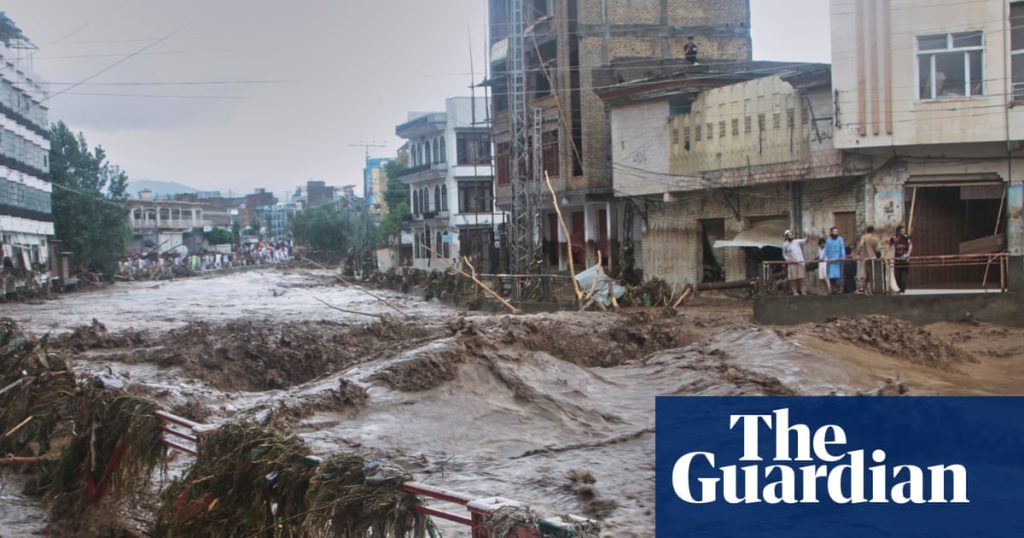A massive cloudburst has triggered flash floods in north-west Pakistan, killing at least 157 people, as rescuers continued to search for people missing after floods in neighbouring India.
Mohammad Suhail, a provincial emergency services spokesperson, said 78 bodies were recovered from various parts of Buner district in the north-west province of Khyber Pakhtunkhwa by noon on Friday, and a further 79 were pulled later from the rubble of collapsed homes and flooded villages.
“The death toll may rise as we are still looking for dozens of missing people,” Suhail said.
The latest fatalities bring to 556 the total number of rain-related deaths in Pakistan since 26 June, according to disaster management officials.
In Bajaur district, in the same province, a helicopter carrying relief supplies crashed on Friday owing to bad weather, killing all five people onboard, a government statement said.
Sudden, intense downpours over small areas known as cloudbursts are increasingly common in India’s Himalayan regions and Pakistan’s northern areas, both of which are prone to flash floods and landslides. Cloudbursts have the potential to wreak havoc by causing intense flooding and landslides, affecting thousands of people in the mountainous regions.
Experts say these intense downpours have become more frequent in recent years, partly owing to the climate crisis, and that the damage caused has also increased because of unplanned development in mountain regions.
Dozens were injured as the deluge destroyed homes in villages in Buner, where authorities declared a state of emergency. Ambulances have transported 56 bodies to local hospitals, according to a government statement.
Rescuers backed by boats and helicopters worked to reach stranded residents. Dozens of villagers were still missing and the death toll was likely to rise, said Kashif Qayyum, a Buner government administrator.
Deaths were reported from different parts of Pakistan on Thursday. Bilal Faizi, a emergency service spokesperson in Khyber Pakhtunkhwa, said rescuers worked for hours to save 1,300 tourists after they were trapped by flash flooding and landslides in the Siran valley in Mansehra district on Thursday.
The Gilgit-Baltistan region has been hit by multiple floods since July, sparking landslides along the Karakoram Highway, a key trade and travel route linking Pakistan and China that is used by tourists. The region is home to scenic glaciers that provide 75% of Pakistan’s stored water supply .
Despite repeated government warnings about landslides and flash floods, many people still visited popular resorts in flood-hit areas in north and north-west Pakistan. A study released this week by World Weather Attribution, a network of international scientists, found rainfall from 24 June to 23 July was 10% to 15% heavier in Pakistan because of global heating. In 2022, the country’s worst monsoon season on record killed more than 1,700 people and caused an estimated $40bn (£29.5bn) in damage.

In Indian-administered Kashmir, rescuers searched for missing people in the remote Himalayan village of Chositi on Friday after 60 people died in flash floods, officials said. Scores of people are missing.
At least 300 people were rescued on Thursday after a powerful cloudburst sparked floods and landslides, but the operation was halted overnight. Officials said many missing people were believed to have been washed away.
At least 50 seriously injured people were treated in local hospitals, many of them rescued from a stream filled with mud and debris. A disaster management official, Mohammed Irshad, said the number of missing people could increase.
Meanwhile, more heavy rain is forecast for the area and is expected to cause flooding.
Chositi in Kishtwar district is the last village accessible to motor vehicles on the route of an annual Hindu pilgrimage to a mountainous shrine. Officials said the pilgrimage, which began on 25 Julyand was scheduled to end on 5 September, was suspended.
Flood waters swept away the main community kitchen set up for the pilgrims, as well as dozens of vehicles and motorbikes. More than 200 pilgrims were in the kitchen at the time of the flood, which also damaged or washed away many of the homes clustered in the foothills, officials said.
Sneha, who gave only one name, said her husband and a daughter were swept away as flood water came down the mountain. Her husband and daughter were having meals at the community kitchen while she and her son were nearby. The family had come for the pilgrimage, she said.
Photographs and videos on social media showed extensive damage, with household goods strewn next to damaged vehicles and homes in the village. Authorities made makeshift bridges on Friday to help stranded pilgrims cross a muddy water channel, and used dozens of earthmovers to shift boulders, uproot trees and electricity poles and remove other debris.
Throughout Friday, authorities evacuated almost 4,000 pilgrims stranded in various parts of the forested area, officials said. Kishtwar district is home to multiple hydroelectric power projects, which experts have long warned pose a threat to the area’s fragile ecosystem.

